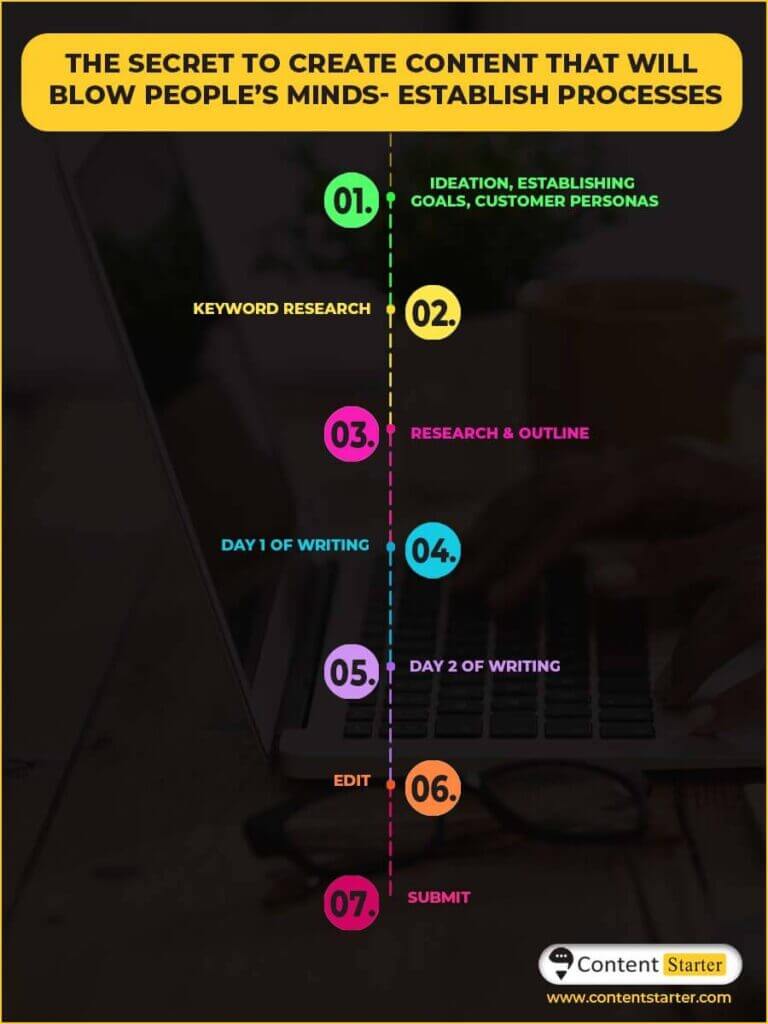How to create content that is better than the rest- Secret Revealed
As a content writer, you want to deliver the best content to your clients. But, there are seldom any rules to writing good content for the internet, which means you can develop your style. However, it means you should work extra hard to write content that your client and users love. It would also be great to write content that ranks on the search page and goes viral. Therefore, you need to focus on two things to create great content- one that the audience loves and one that the search engines love. We can’t give you a detailed guide on how to do either, but we can give you a secret to writing high quality content- making a writing process/framework. Sound anti-climatic and boring? It is the secret of producing amazing content without exhaustion and burnout.
Additionally, we have some tips to potentially write a viral write-up as per observations made by marketers on some viral content on the internet. So if you are ready for a blog filled with value bombs on how to make content and secrets nobody dares to share, keep reading.
Secret steps to creating quality content
Establish your writing process
Stephen King writes ten pages daily according to his memoir on writing. It is approximately 5000 words every day. As a creative writer, it may seem insane and a strategy for failure, but he has been able to write best-selling books for years now; several producers made his books into movies.
As a quality content writer, you can learn from him his dedication to his processes and making those processes a habit. You can excel as a content writer and produce good content only when you create a method of writing and stick to it like clockwork. Understandably, you can’t write 5000 words, which doesn’t mean you are a lousy writer. But, you need to assess your writing capacity and see how much you can write in a day and do it every day.
But wait, won’t following a system make you lose your creativity? It is a question even I was wondering when I first started establishing and tweaking my process. If I start writing like a robot, won’t my writing lose its magic? Moreover, we see creativity as this fleeting and rare thing, so we wait for it to appear so we can finally start writing our best work. But, we keep waiting, and the damned creativity seldom arrives.
But with a process in place, I saw one amazing thing happening. It made writing easier and faster, as per my experience. Why? Because my process made me aware of what to do and how to do it exactly. Since I repeat the process every day, I know what to do, and my brain is free to be creative. Therefore, processes boost your creativity instead of destroying it.
But how to start making a process too? And what if my process fails? Fair enough, the first one I can help you with and have answered below. The second one is something you would have to experiment with to get it right. I am still tweaking mine and seeing what works for me. Thus, the second one is bound to happen, and you have the control to change the process until you get to one that fits you.
You can use the following process or framework to make your own and tweak it. It is the one I use, and it has worked for me so far.

Ideation
The first step deals with the ideation of the piece. Many content writers are not a part of the ideation process, and therefore it may not apply to you. However, I want to write an inclusive blog for every content writer. Thus, you should start ideating and thinking about which person will benefit from the blog you are writing. Moreover, establishing what you want from the blog will also help you craft better content because it will be more specific and targeted.
How to create content ideas out of thin air? When you work in a niche, content ideas start to get repetitive. The repetitiveness can suck the joy out of writing, and nobody likes to hate their job. So, you can use a few tricks to ideate from thin air.
Talk to other writers from your niche for some good content ideas; since they are working in a similar field, they would have some fresh ideas and perspectives that you didn’t know. You should also check out blogs in your niche and see what they have been writing about; it will give you more ideas for your clients. Blogs are not the only way to look for more ideas; you can also check YouTube channels and social media pages for ideas. The content on social media is short, and it is tough to write long blogs posts from posts on social media. However, social media posts give you a good starting point. You can also Answer The Public to look for what your target audience is searching for and write a high-quality content piece. You will have multiple ideas, and you will eventually stumble upon new information which will give you more ideas.
Keyword research
Do keyword research to write good content that the algorithm likes and reaches the target audience. Your keywords can also include the terms your customer persona will search on Google. It would help if you ideally used a tool like Ahrefs or Semrush for your keyword research since they give you more targeted keywords. Moreover, with Ahrefs and Semrush, you can see which keywords they are using to rank and use them yourself. Furthermore, you can even see the difficulty of ranking for the keywords. The more difficult it is to rank for the keyword, the more you should be careful while using it. The easier the keyword is to rank, the more you should use it, given the search volume is decent.
Keyword research is challenging because it is a game of trial or error. If you do not provide the keyword research service, you can ignore this section and move on to the next. But if you offer it as a service in addition to content writing, go ahead and use the tips above.
Research and Outline
Once you have finalised the keywords, you need to search which articles rank for the keyword and topic. You need to write a better article than the ones ranking currently. So, if the first result is ten ways to do X, you need to find 15 ways to do X. Add more value and information to your blog. The more you will read the blogs that are ranking; you will see similarities in terms of titles and subheadings. Note them down and make your outline.
What is an outline? An outline is the skeleton of your blog. It comprises your blog’s title, heading, and subheadings and a brief description of each sub-heading. The description can also have interesting tidbits or links to reference blogs. The outline helps writers tremendously and is one of the most underrated techniques for improving a blog or any other form of content.
Writing the first draft.
There are two days dedicated to writing in the above example, but that is an example only. The number of days it will take you to finish the first draft depends on how long the content piece is and your speed. For instance, if the blog you are supposed to write is 3000 words, and you can write 1000 words per day, it will take you three days to write. You can be slower or faster; the point is to establish your limit and see how many days it will take you to finish the first draft.
When writing the first draft, do not overthink it and just write. Make errors and mistakes; it’s okay. The point is to write and get in a flow state (in-depth information about flow and deep work in a later section). Once you are in flow, you are writing better and enjoying the process of writing too. Therefore, the first draft can be as messy and flawed as the first time you wrote.
Write a lousy first draft.
I understand that many writers are uncomfortable with writing a lousy draft; they have the perfectionist who wants each sentence to make sense with the one above. But, it is time-consuming, ineffective, and a disappointing process. It takes more time when you are trying to be perfect at each step. Moreover, the point of the first draft is to articulate your thoughts, and you cannot do that effectively when you are focused on making those thoughts perfect too. Moreover, perfection is subjective and often a vague concept, that chasing it is disappointing and can make your content writing job less content. Therefore, focus on articulating thoughts in the first draft and editing.
Editing
Editing is magical; it is where you take a lousy draft to the best you can write. Editing grammatical errors are critical, and you can use Grammarly too (our review is here). But another crucial aspect of editing is making sure the flow of the content is correct, and there is clarity in your high quality content. Each sentence should be easy to read and comprehend for your customer persona. Moreover, you need to maintain an active voice in most sentences, use a variety of transition words, and include lists as much as possible because it makes skimming easy.
Document your process
It is one task to make a process; it is a separate task to document and follow the process. If you don’t document it, you won’t ever follow it. What do I mean by document? Write it down somewhere and track which stage of the process you are currently for your ongoing projects. It gives you a quick overview and keeps you on top of things. Refer to the image to understand what we mean by documenting your process and tracking where you are in the process.
As I did in the image above, you can use Google Sheets and Google Docs for it, but many don’t find its interface the best. Thus, you can use Notion, one of the easiest and functional interfaces. Unlike the Google experience, your tables and texts can be accessed via the sidebar. Moreover, you can use Kanban boards too in Notion and therefore, tracking and documenting processes is easy. Notion is free for a single person but costs if you scale, so keep that in mind when you are trying Notion.
Look, your processes don’t have to look like mine; if you feel you can do the ideation and keyword research on the same day, you do that. If it takes you only one day of writing, you can do that. You are making a process to make life easier and take off some mundane tasks from your plate. Thus, keep tweaking and find the strategy that works for you.
Deep work and achieving flow
Great content is hard to create, which is not a new thing. Because good content and art are rare and unique, we immediately recognise them when we see excellent content. Even the meaning of good content is subjective, so, as high-quality content writers, our job is to write at our best and do justice to the readers who took the time to read it. And the only way to do justice to our readers is to write when we are at our optimum and our optimum when we are in a state of flow. Flow is a state of being when you are so engaged with what you are doing that time and space no longer matter. If you were ever writing and looked up to see that two hours had passed without you even noticing, you were in the state of flow.
The state of flow is a bit elusive to achieve, but working deeply can help you attain it. Deep work is doing work that cannot be easily replicated by someone else, and the work is done in an environment that is a distraction. So if you have the habit of checking your phone every 10 minutes, you distract your mind, and therefore it will be tough for you to achieve the flow state and work deeply.
Moreover, deep work cannot be sending emails because if you hired an assistant today, your assistant could send emails, and nobody would notice. But if somebody with a different skill set wrote your projects, there will be a clear difference, and therefore writing is work that cannot be replicated without a proper skill set that takes people months and years to improve.
What are the benefits of flow state, and why should you even bother? Well, you should because the benefits are pretty amazing like:
- You pay attention to crucial and positive things.
- Your performance improves.
- The skill learning accelerates in a flow state, so you become a better writer fast.
- Increased enjoyment and creativity.
- And lastly, it makes you more productive.
You would also like: Complete Guide To Make A Content Writer Portfolio That Will Blow Your Client’s Minds
How to make good content that can potentially go viral- more secret tips
Virality is the success that has so many variables involved that nobody guarantees virality. However, you can learn from people who have made viral campaigns possible and study why they went viral. And the virality of a blog depends on how shareable it is. Since you can earn increasing the page views by simply running it as an ad, page views are not necessarily a good metric. However, tracking how many people have shared your blog or a social media post is the right way to gauge the virality.
Sharing is the accurate indicator of a good content piece connected with the audience because they are willing to share it with other people. The blog or article either has terrific information that helps the people or is written so well that sharing it makes the sharer’s social status higher in front of his peers. The content piece may also elicit strong emotions that he wants to share with his friends and make them emotional. It is why emotional ads are so viral on social media and WhatsApp.
Virality is a game of triggering emotions in humans, and therefore understanding psychology is crucial. It is also a game of luck, so consequently, the idea should be to produce as many good content pieces as possible and see what works and repeat it. Thus, the volume of content, understanding of human psychology, and implementation of it in your content dictate virality. To understand virality more, you can read Fast, cheap, and viral by Aashish Chopra and Contagious by Jonah Berger.
I will give you some tricks from their observations; I hope it helps your next high-quality content piece viral:
Learn copywriting
What if your readers did what you want them to do at the end of the blog or article. You ask them to share it, and they do so. Voila! You would soon end up with a viral blog post, and your clients will be super happy (you can ask for a glowing testimonial or a retainer contract right now).
Copywriting is the art and science of writing words that move people to take the action you want them to take. It might sound like magic, but people have been writing copy to persuade people and sell their products for ages as content writers; upskilling and practising copywriting daily will give that oomph to your content.
A wacky headline
There is no point in writing a good content piece if the heading sucks and nobody clicks on it. Therefore, if the client is from the industry where writing a wacky headline is okay, you should go ahead and write that out of the box, crazy headline. However, make sure it is not clickbait. Within the first 100 words, clarify what the blog is about. For example, if the headline is “you won’t believe what the secret to a healthy gut is”, within the first 100-150 words, reveal it but encourage them to read further why it is so and the scientific evidence behind this secret. This way, you hook them in and tell your secret but encourage them to read further to avoid leaving the webpage.
Triggers
Do you know that a song called Friday sees a spike in views during Fridays? People search and listen to it on Fridays since it triggers them. Triggers are a great way to make something stick in someone’s head for a long while, and therefore using triggers can also be a great way to add the spice of virality to your content. But using triggers can be tricky, and try to look at the context of the message and see if the environment has triggers that can make them think of your content.
For example, more people voted for school funding programs if the voting location was a school. Thus, if your blog is B2B, try including Zoom meetings in your content so that the meetings your readers attend remind them of your blog.
Conclusion
You are ready to write good content and make your clients happy. Let’s quickly sum up everything we discussed:
- The secret to creating quality content is establishing processes.
- Processes make your writing easy since it takes away the burden of making decisions each day.
- Processes make writing faster since you get used to the repeatable process.
- We also saw an example of a writing process and what each part of the process meant.
- You should tweak your process according to your skillset, time, speed, and workload.
- Documenting your process is critical to using your process, and you can use Google Sheet or Notion for the same.
- Deep work and flow are crucial to writing, writing fast, and producing great content.
- Making your high quality content viral is not guaranteed, but you can plant things that can make your content viral.
- Virality’s accurate metric is shareability. Focus on how much sharing of your content is happening.
- If you can make people feel something, give valuable information, and share your content will make them intellectually superior, there are higher chances of them sharing your content.
- Three ingredients that can make your content viral are using copywriting to engage the user and share the content.
- Wacky headlines are limited to some industries but are great for pulling people in and building curiosity.
- Triggers are a great way to keep people coming back and depend on context.
We hope the blog helped you and gave you rarely shared information. If yes, you can follow us on our social media for more bomb high quality content: Instagram, Facebook, Pinterest, and Twitter.





